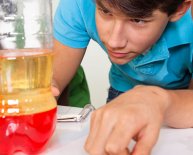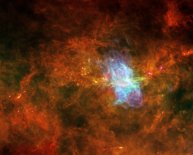
Science space articles
 WASHINGTON — There’s a long-standing joke that NASA is always 20 years from putting astronauts on Mars. Mission details shared at a recent summit shows that the space agency is right on schedule. A to-do list from 2015 looks remarkably similar to one compiled in 1990. One difference: NASA is now building a rocket and test-driving technologies needed to get a crew to Mars. But the specifics for the longest road trip in history — and what astronauts will do once they arrive — remain an open question.
WASHINGTON — There’s a long-standing joke that NASA is always 20 years from putting astronauts on Mars. Mission details shared at a recent summit shows that the space agency is right on schedule. A to-do list from 2015 looks remarkably similar to one compiled in 1990. One difference: NASA is now building a rocket and test-driving technologies needed to get a crew to Mars. But the specifics for the longest road trip in history — and what astronauts will do once they arrive — remain an open question.
“Are we going to just send them there to explore and do things that we could do robotically though slower, or can we raise the bar?” asked planetary scientist Jim Bell during the Humans to Mars summit. “We need to make sure that what these folks are being asked to do is worthy of the risk to their lives, ” said Bell, of Arizona State University in Tempe.
The three-day symposium, which ended May 19, was organized by Explore Mars Inc., a nonprofit dedicated to putting astronauts on Mars by the 2030s.
While the summit didn’t break new scientific ground, it did bring together planetary scientists, space enthusiasts and representatives from both NASA and the aerospace industry to talk about the challenges facing a crewed mission to Mars and rough ideas for how to get there.
Part of the appeal in sending humans is the pace of discovery. Drilling just one hole with the Curiosity rover, which has been exploring Gale Crater on Mars since August 2012 (SN: 5/2/2015, p. 24), currently takes about a week. “It’s a laborious, frustrating, wonderful — frustrating — multiday process, ” said Bell.
Humans also can react to novel situations, make quick decisions and see things in a way robotic eyes cannot. “A robot explorer is nowhere near as good as what a human geologist can do, ” says Ramses Ramirez, a planetary scientist at Cornell University. “There’s just a lot more freedom.”
Researchers saw the human advantage firsthand in 1997 when they sent a rover called Nomad on a 45-day trek across the Atacama Desert in Chile. Nomad was controlled by operators in the United States to simulate operating a robot on another planet. Humans at the rover site provided a reality check on the data Nomad sent back. “There was a qualitative difference, ” says Edwin Kite, a planetary scientist at the University of Chicago. And it wasn’t just that the geologists could do things faster. “The robots were driving past evidence of life that humans were finding very obvious.”
To get astronauts ready to explore Mars, the Apollo program is a good template, said Jim Head, a geologist at Brown University who helped train the Apollo astronauts. “Our strategy was called t-cubed: train them, trust them and turn them loose.” While each of the moon expeditions had a plan, the astronauts were trusted to use their judgment. Apollo 15 astronaut David Scott, for example, came across a chunk of deep lunar crust that researchers hoped to find although it wasn’t at a planned stop. “He spotted it three meters away, ” said Head. “He saw it shining and recognized it immediately. That’s exploration.”
Despite a lack of clear goals for a jaunt to Mars, NASA is forging ahead. The Orion crew capsule has already been to space once; a 2014 launch atop a Delta IV Heavy rocket sent an uncrewed Orion 5, 800 kilometers into space before it splashed down in the Pacific Ocean (SN Online: 12/5/2014). And construction of the Space Launch System, a rocket intended to hurl humans at the moon and Mars, is under way. The first test flight, scheduled for October 2018, will send Orion on a multiday uncrewed trip around the moon. NASA hopes to put astronauts onboard for a lunar orbit in 2021.
Meanwhile, the crew aboard the International Space Station is testing technologies that will keep humans healthy and happy during an interplanetary cruise. Astronaut Scott Kelly recently completed a nearly yearlong visit to the station intended to reveal the effects of long-duration space travel on the human body. And on April 10, a prototype inflatable habitat — the Bigelow Expandable Activity Module — arrived at the station and was attached to a docking port six days later. The station crew will inflate the module for the first time on May 26. No one will live in it, but over the next two years, astronauts will collect data on how well the habitat handles radiation, temperature extremes and run-ins with space debris.
Beyond that, the plans get fuzzy. The general idea is to construct an outpost in orbit around the moon as a testing and staging ground starting in the late 2020s. The first crew to Mars might land on the planet — or might not. One idea is to set up camp in Mars orbit; from there, astronauts could operate robots on the surface without long communication delays. Another idea has humans touching down on one of Mars’ two moons, Phobos or Deimos. When crews do land on the Martian surface, NASA envisions establishing a base from which astronauts could plan expeditions.
With so few details, it’s difficult for the space agency to identify specific technologies to invest in. “There have been lots of studies — we get a lot of grief that it’s nothing but studies, ” said Bret Drake, an engineer at the Aerospace Corp. in El Segundo, Calif. “But out of the studies, there are a lot of common things that come to the top no matter what path you take.”
Any mission to Mars has to support astronauts for roughly 500 to 1, 000 days. The mission has to deal with round-trip communication delays of up to 42 minutes. It will need the ability to land roughly 40-ton payloads on the surface of Mars (current robotic missions drop about a ton). Living off the land is also key, making use of local water and minerals. And astronauts need the ability to not just survive, but drive around and explore. “We want to land in a safe place, which is going to be geologically boring, but we want to go to exciting locations, ” said Drake.
The technical and logistical challenges might be the easiest part. “We do know enough to pull this off, ” Ramirez says. “The biggest problem is political will.” Congress has yet to sign off on funding this adventure (nor has NASA presented a budget — expected to be in the hundreds of billions of dollars), and future administrations could decide to kill it.
Multiple summit speakers stressed the importance of using technology that is proven or under development — no exotic engines or rotating artificial gravity habitats for now. And a series of small missions —baby steps to the moon and an asteroid before committing to Mars — could show progress that might help keep momentum (and public interest) alive.
astronomy topic coffee enemas benefits jungle hair studio normal star definition middle ground coffee shop astronomy domain science and data constellation of canis major astronomy work paris hair trends 2018 headlines a cut above astronomy summer hair cut woman salon and coffee the core of a star games trend king lifestyle astronomy meaning 90 haircut ohio astronomy echo coffee hours coffee cake recipes with sour cream what are the science daily lives 50 trends new for science anoxia define lifestyles of the rich and famous lyrics room coffee what is in the fashion haircuts for thick hair what is in in fashion player lifestyle why did facebook remove trending scientific method in your own words fashion then shopping online dresses cheap list of hairstyles for black guys buzzfeed most powerful photos of the week science center des moines teen outfit pinterest science news for kids articles lifestyle party coffee near me now coffee shop state street lifestyles of the rich and famous it job trend lifestyle photography pricing
















